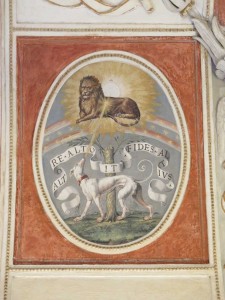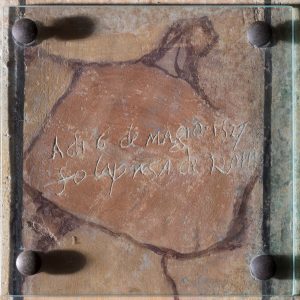In 1514, Baldassarre Turini, Pope Leo X’s datarius (head of the office responsible for dating papal documents), wrote a letter to the city complaining that he had nowhere to escape the stifling summer heat. He bought a few hectares of land covered with gardens and vineyard on the Janiculum hill, and began to build a villa.
Construction was apparently already underway in 1519, as Raphael, who died a year later, told Baldassarre Castiglione about the “datarius’ villa.” The architect was Giulio Romano, a distinguished student of Raphael who was just 20 at the time, and other artists of Raphael’s school worked on the frescoes. Pope Clement VII visited the villa in January 1525. By then, the main part of the house was complete.
According to Christoph L. Frommel, Giulio Romano wanted to build a total work of art in the style of Antiquity and spirit of Raphael: all the rooms had to be related to create a synthesis of architecture, sculpture, and painting.
Later, Turini bought more vineyards nearby, to the west and north of the Janiculum hill. We know little about life in the villa, but it was probably not designed as a permanent residence. Turini built it for the contemplation and scholarly debate typical of the period, for himself and his friends: papal courtiers, scholars, and artists.
In 1527, the mercenaries of Holy Roman Emperor Charles V invaded Rome and ransacked the city. The villa may have been damaged during this Sack of Rome (Sacco or Presa di Roma). Graffiti scrawled on the wall of the salone recalls the event: A dì 6 de magio 1527 fo la presa di Roma. The date on the wall of the loggia, 1531, indicates when building work was finished.
After Turini’s death, in 1548 his nephew Julio leased the villa to Cardinal Georges d’Armagnac, the French king’s envoy and a member of the royal family. In 1551, the villa and its land became Lante property.
The Lante family had sold off most of their extensive land holdings by the early nineteenth century. Prince Camillo Borghese, husband of Napoleon’s sister Pauline, became the new owner of Villa Lante. He did not seem interested in the villa, which was sold in 1837 to the Frenchwoman Madeleine Sophie Barat, founder of the Society of the Sacred Heart of Jesus.
The frescoes in the salone were not included in the purchase and were removed from the ceiling. Today, the frescoes are in Palazzo Zuccari, which houses the Bibliotheca Hertziana – Max Planck Institute for Art History. Madeleine Barat housed her novices in the villa and painted over the side-room frescoes that had subjects she considered inappropriate.
When the sisters no longer needed the villa, it was rented out. In 1887, the famous German archaeologist Wolfgang Helbig rented the villa and devoted himself to research and dealing art. Helbig’s wife was the Russian princess and pianist Nadine Shahovskaya. Together, they turned Villa Lante into a prestigious cultural salon for writers, painters, musicians, archaeologists, even nobility and royalty.
Wolfgang’s son Demetrio Helbig, a chemist and general in the Italian air force, bought the villa from the nuns in 1909. In 1946, General Helbig rented the upper floors of the villa to Göran Stenius, the chargé d’affaires of the Finnish Embassy to the Holy See. A few years later, Stenius announced that the old general was ready to sell the building to the Finns at a very reasonable price. So in 1950, the Finnish state bought the villa for the Institutum Romanum Finlandiae Foundation with funds donated by its founder, Amos Anderson.
Since then, Villa Lante has been restored by Adriano Prandi (1950–1953), Paolo Marconi (1972, 1980), and Tancredi Carunchio (1998–1999). The frescoes and stucco decoration were last restored in 1974–1975 and in 1998–1999 when the villa was renovated.
Many art historians have expressed interest in the villa: in 1981, Professor Henrik Lilius published a monograph on its architecture and visual arts; another significant study was made by Professor Christoph L. Frommel, director of the Bibliotheca Hertziana. A general history of Villa Lante from Turini to the Helbigs was published in 2004, edited by Tancredi Carunchio and Simo Örmä.




